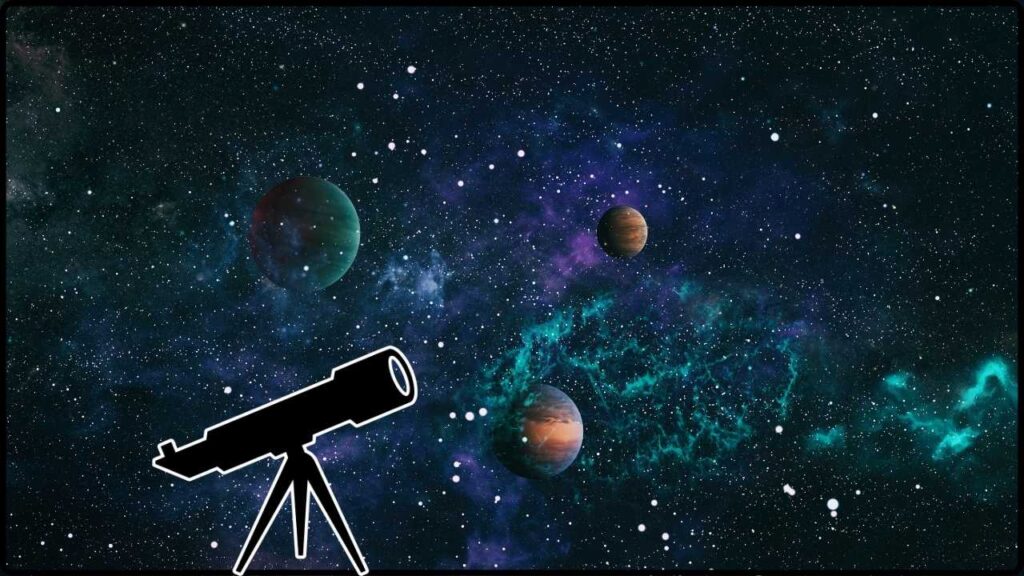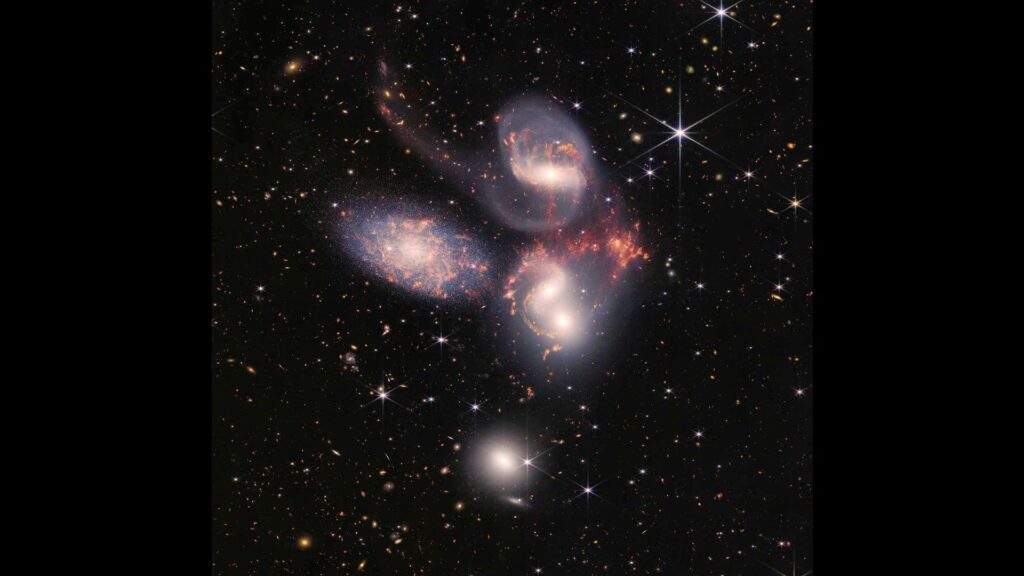
James Webb Space Telescope Captures Enormous Cosmic Structures: The James Webb Space Telescope (JWST) has just made a groundbreaking discovery that has left scientists and space enthusiasts alike in awe. For the first time, this extraordinary telescope has captured images of cosmic structures containing dozens of galaxies within a single frame, providing an unprecedented look into the early universe. As the most powerful space telescope ever launched, JWST is offering a deeper understanding of how galaxies evolve and form, taking us on a journey through space and time like never before. In this article, we’ll explore how this discovery came to be, why it’s so important for our understanding of the universe, and what it means for the future of space exploration. Along the way, we’ll provide clear explanations, useful context, and some fun facts to help both beginners and experts appreciate this monumental achievement.
James Webb Space Telescope Captures Enormous Cosmic Structures
The James Webb Space Telescope’s ability to capture these enormous cosmic structures is a monumental achievement in space exploration. With over 800,000 galaxies and 1,678 galaxy groups observed, this discovery provides a deeper understanding of the universe’s history and the evolution of galaxies. As scientists continue to analyze the data from the COSMOS-Web survey, we can expect to learn even more about the formation of galaxies, the role of supermassive black holes, and the forces that shape our universe. This discovery also paves the way for future space exploration and cosmic studies, offering a glimpse into the future of astronomical research. The James Webb Space Telescope continues to break barriers in our understanding of the cosmos, and this is just the beginning.
| Key Discovery | Details |
|---|---|
| Telescope Used | James Webb Space Telescope |
| Number of Galaxies Captured | Over 800,000 galaxies and 1,678 galaxy groups |
| Discovery Significance | Provides insights into galaxy evolution and formation |
| Timeframe | Observations date back to 6.5 billion years ago |
| Survey Name | COSMOS-Web survey |
| Source for More Info | NASA |
| Area Observed | Approx. 0.54 square degrees, about the size of 2.5 full moons |
| Total Exposures | Over 10,000 individual exposures |
Introduction: What Is the James Webb Space Telescope?
Before diving into the specifics of this amazing discovery, let’s take a moment to understand what the James Webb Space Telescope is and why it’s so important. The JWST is a highly advanced space observatory, launched on December 25, 2021, as a joint project between NASA, the European Space Agency (ESA), and the Canadian Space Agency (CSA). This telescope is designed to study the universe in infrared light, which allows it to peer through dust clouds and observe objects far beyond the reach of earlier telescopes like Hubble.
The JWST is capable of observing galaxies, stars, and planetary systems from over 13 billion years ago, providing invaluable insights into the formation of the universe. Its powerful instruments allow scientists to study celestial bodies with unprecedented clarity, unlocking secrets that were once beyond our reach.
The Groundbreaking Discovery
The discovery of these enormous cosmic structures by JWST is part of the ongoing COSMOS-Web survey. This survey focuses on a patch of the sky that is roughly 0.54 square degrees in size—about the area covered by two and a half full moons. This section of space, though seemingly small, contains a treasure trove of information, revealing over 800,000 galaxies and 1,678 distinct galaxy groups.
What makes this discovery so stunning is not just the sheer number of galaxies, but the immense scale and diversity of the structures observed. These galaxies are not scattered randomly across space but are instead organized into large, interconnected galaxy clusters—some of the largest gravitationally bound structures in the universe.

Why Is This Discovery Important?
Understanding the formation and evolution of galaxies is one of the most significant questions in modern astronomy. Galaxies are the building blocks of the universe, and studying their growth over time can reveal crucial details about the cosmic history. The more we know about how galaxies come together, merge, and evolve, the better we can understand dark matter, dark energy, and the fundamental forces that shape the cosmos.
This discovery is particularly exciting because it offers a glimpse into the past, allowing scientists to study how galaxies looked when the universe was still in its early stages—around 6.5 billion years ago. By looking at the light emitted from these ancient galaxies, JWST gives us a window into an era that we could only speculate about before.
The ability to observe these distant galaxies with such detail helps scientists answer some critical questions:
- How do galaxies form and grow?
- What role do supermassive black holes play in galaxy evolution?
- How do galaxy clusters interact with each other over time?
By answering these questions, JWST helps us piece together the history of our universe, from its earliest moments after the Big Bang to its current state.
Breaking Down the Discovery: What Was Found?
In this survey, scientists discovered a diverse array of cosmic structures, with the most significant finding being the most massive galaxy group ever observed by the JWST. These galaxy groups are massive, with dozens of galaxies bound together by gravity. Some of these structures are so large that they stretch across vast distances in the universe, containing millions of stars and supermassive black holes.
One of the most important aspects of this discovery is that it challenges our understanding of galaxy formation. The traditional view is that galaxies form individually over billions of years. However, this discovery suggests that galaxies may have formed in clusters earlier than previously thought, with galaxy mergers playing a much larger role in the process.
The images taken by JWST also revealed intricate details of galaxy shapes, sizes, and interactions. Some of these galaxies appear distorted, likely due to the immense gravitational forces of nearby galaxy clusters. These observations provide scientists with an opportunity to study gravitational lensing, a phenomenon where light from distant objects is bent and magnified by massive objects in the foreground.

How Did the James Webb Space Telescope Captures Enormous Cosmic Structures?
The COSMOS-Web survey required more than 10,000 individual exposures, or images, which were combined to create a comprehensive view of the observed area. Each exposure was taken by the telescope’s powerful instruments, including its Near-Infrared Camera (NIRCam) and Mid-Infrared Instrument (MIRI). These instruments allow JWST to detect infrared radiation, which passes through the dust and gas clouds that often obscure objects in visible light.
These detailed images were then carefully stitched together to form a high-resolution mosaic, allowing scientists to study the universe in more detail than ever before. The infrared capabilities of JWST allow it to capture objects that are too faint to be seen by other telescopes, revealing hidden details about the early stages of galaxy formation.
Potential Implications for Future Research
The implications of this discovery go far beyond just understanding the formation of galaxies. The JWST’s observations will likely shape the direction of future astronomical research for years to come. As scientists begin to analyze the data from this massive survey, we can expect to uncover more about dark matter, dark energy, and other cosmic phenomena that remain a mystery.
Moreover, the study of galaxy clusters will help us understand the large-scale structure of the universe. Galaxy clusters are the largest gravitationally bound structures, and learning how they evolve gives us crucial insights into cosmic growth and the fate of the universe.

What Are the Next Steps?
As of now, scientists are still processing the wealth of data gathered by the COSMOS-Web survey. There are many unanswered questions, including how galaxy clusters interact and how supermassive black holes influence the growth of galaxies. The JWST’s infrared capabilities will continue to be an invaluable tool in studying these cosmic phenomena, helping scientists unlock more secrets about the early universe.
Upcoming missions and new surveys will build on these findings, using the JWST’s data to further probe galaxy formation, cosmic evolution, and the physics of the universe at a level of detail never before possible.
Trump’s New NASA Budget Proposal Cuts Deep—Some Changes Called ‘Literally Draconian’
It’s Official: NASA Just Confirmed What the Oceans Really Look Like from Space
NASA Just Discovered Solar Curtains on the Sun—Here’s How This Plasma Spectacle Forms











